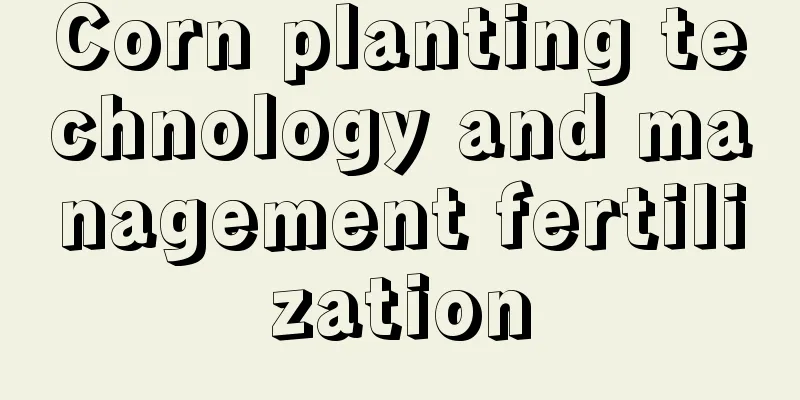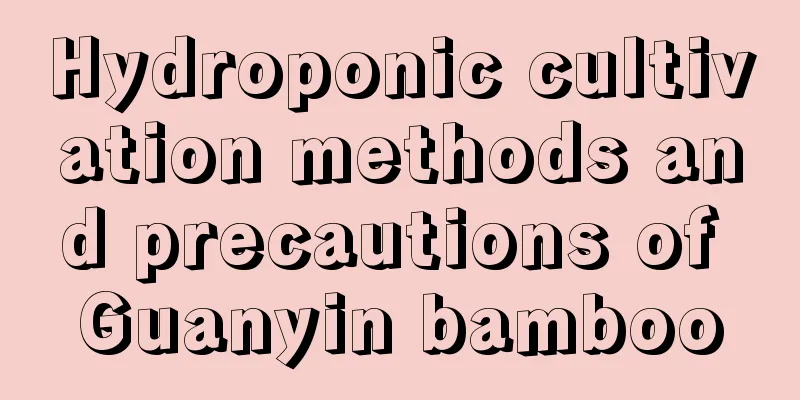Corn planting technology and management fertilization

|
Corn is an important food crop, and its cultivation technology directly affects the quality and yield of corn. Corn has different requirements for environment and management conditions at different growth stages. Let’s learn about corn planting techniques and management and fertilization. 1. Planting management 1. Select seeds Among the many corn varieties, it is crucial to choose seeds that are suitable for local climate and environmental conditions. Priority should be given to varieties with suitable maturity period, strong disease resistance and good lodging resistance. Correct seed selection lays the foundation for high and stable yields. 2. Seed treatment The seeds are carefully processed, including screening to remove diseased seeds and impurities, drying them in the sun for 3-4 days, disinfecting or coating the seeds with drugs, and soaking them to accelerate germination, to ensure that they germinate quickly, completely and robustly after sowing. 3. Sowing and dense planting The sowing period should be determined based on the ground temperature being stable at above 5 degrees Celsius, and early sowing should be done to extend the growing period. The planting density should be based on the characteristics of the seeds and the light and air permeability of the field. Generally, a spacing of 35-40 cm between plants is appropriate. 4. Seedling filling and thinning Observe the condition of the seedlings, replant or transplant missing seedlings in time, and thin out the seedlings, removing weak seedlings to provide space for strong seedlings. At the same time, remove weeds to avoid competing with corn seedlings for nutrients and water. 5. Irrigation management The water requirement is not large during the seedling stage, so pay attention to drainage to prevent waterlogging. The water demand increases during the growing period, and irrigation should be carried out in time according to weather changes to meet the water needs of corn. 6. Disease prevention and control There are many types of corn diseases, including large and small leaf spot, head smut and virus diseases, which can cause leaf damage, ear rot and significant yield reduction. Preventive and curative measures should be taken, such as selecting disease-resistant varieties, rational crop rotation, timely removal of diseased and dead parts, and the use of biological or chemical control methods. 2. Fertilization management 1. Apply enough basal fertilizer Before corn planting, the application of basal fertilizer is crucial. The main methods of fertilization include broadcasting, strip application and hole application. Among them, strip application and hole application are more conducive to root absorption and have better effects because the fertilizer is close to the corn roots. Fertilizers should be mixed thoroughly before application to ensure even distribution. Mix fertilizer into the soil as you till the land . For base fertilizers such as nitrogen fertilizer and phosphorus fertilizer, two methods are recommended: strip application and point application. 2. Use good seed fertilizer Seed fertilizer is a fertilizer applied at or near the time of sowing to aid the early development of seeds and seedlings. Choosing quick-acting fertilizers, such as urea, ammonium bicarbonate, diammonium nitrate, etc., can promote root absorption. When applying, be sure to keep the fertilizer 10 cm away from the seeds to avoid damaging the seeds. At the same time, the appropriate application of phosphorus and potassium fertilizers can significantly improve fertilizer efficiency. 3. Apply fertilizer in batches Top dressing is usually carried out at different stages of corn growth, generally more than three times, namely at the jointing stage, heading stage and filling stage. Studies have shown that reasonably increasing the number of topdressing times can increase yields, but it needs to be controlled within an appropriate range to avoid excessive fertilization. 4. Attacking rod fertilizer Apply it during the jointing stage to promote the differentiation of the root system and male and female ears, usually one and a half to two months after sowing, when 6 to 7 leaves have unfolded. The fertilization position should be 10 to 15 cm around the plant, and the trench depth should be 5 to 10 cm. 5. Fertilizer for ear Apply between the jointing stage and the stagnant stage, when 13 to 15 leaves have unfolded for spring corn and 11 to 13 leaves have unfolded for summer corn. Fertilization during this period directly affects the fruit size and number of rows, and quick-acting nitrogen fertilizer can be applied in combination with tillage and watering. 6. Granular fertilizer Application during the grain filling period, 10 to 15 days before harvest, affects grain weight and yield. It is recommended to apply urea at 120-150 kg/hm² or by foliar spraying. 7. Reasonably adjust the amount of fertilizer If too much base fertilizer is applied, the amount of seed fertilizer can be reduced appropriately; otherwise, it should be increased appropriately. Generally speaking, the recommended application rate of high-quality organic fertilizer is 4500-7500kg/hm², urea is 120-150kg/hm², and diammonium phosphate is 120-150kg/hm². In general, through scientific planting management and fertilization techniques, the growth conditions of corn can be effectively improved, thereby increasing yield and quality.
|
<<: What vegetables to plant in spring
Recommend
How to preserve ginkgo seeds and what is the probability of survival
1. Storage method The common storage method for g...
The cultivation technology of Kochia scoparia
1. Use soil Red Kochia has very tenacious vitalit...
What to do if the roots of the cycads are rotten
Why does the root of the hyacinthus rot? The soil...
The difference between sleeve coconut and rich coconut
1. Differences in stems The stem of the sleeve co...
Why did the daffodils suddenly become soft?
1. Lack of sunlight 1. Reason: Daffodils prefer s...
Can Paris Kalanchoe be cultivated into an old pile (Can Paris Kalanchoe be cultivated into an old pile for many years)
Question about whether Paris Kalanchoe can be use...
The correct way to grow water lilies
Water lily is a perennial aquatic herb that looks...
What is the reason for the withering of the branches of the fortune tree?
1. Lack of light Reason: Long-term lack of light ...
What are the cultivation methods and precautions of boxwood?
Boxwood cultivation method Boxwood is a plant of ...
How often should I water asparagus fern in winter?
1. Watering frequency The temperature in winter i...
How to make cuttings of Euphorbia milii take root quickly
Euphorbia pulcherrima is a succulent plant with c...
Causes of Deformed Tomato Fruits (Main Prevention and Control Measures for Deformed Tomato Fruits)
1. Tomato flower bud differentiation problem Ther...
What are the breeding methods and precautions for Milan?
Milan growth habits Milan likes warm and humid en...
Banyan bonsai maintenance tips for four seasons
Spring maintenance Repotting As the temperature r...
Common diseases and prevention methods of Milan flowers
Milan flower diseases: Anthracnose symptom Anthra...









